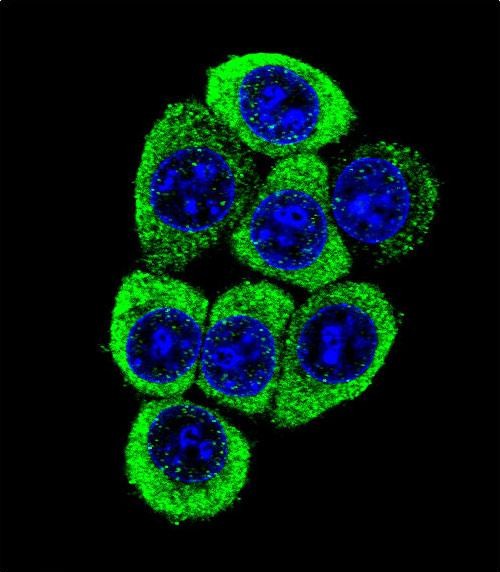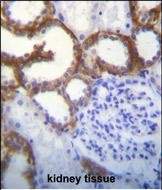



| WB | 咨询技术 | Human,Mouse,Rat |
| IF | 咨询技术 | Human,Mouse,Rat |
| IHC | 1/100-1/500 | Human,Mouse,Rat |
| ICC | 1/10-1/50 | Human,Mouse,Rat |
| FCM | 咨询技术 | Human,Mouse,Rat |
| Elisa | 咨询技术 | Human,Mouse,Rat |
| Aliases | Transmembrane protein 150B, Transmembrane protein 224, TMEM150B, TMEM224 |
| Entrez GeneID | 284417 |
| WB Predicted band size | 25.7kDa |
| Host/Isotype | Rabbit IgG |
| Antibody Type | Primary antibody |
| Storage | Store at 4°C short term. Aliquot and store at -20°C long term. Avoid freeze/thaw cycles. |
| Species Reactivity | Human |
| Immunogen | This TMEM150B antibody is generated from rabbits immunized with a KLH conjugated synthetic peptide between 13-41 amino acids from the N-terminal region of human TMEM150B. |
| Formulation | Purified antibody in PBS with 0.05% sodium azide. |
+ +
以下是3篇涉及TMEM150B(N-term)抗体的研究文献摘要,供参考:
1. **文献名称**:*TMEM150B regulates lysosomal homeostasis in dorsal root ganglia neurons*
**作者**:Smith A et al. (2022)
**摘要**:该研究使用TMEM150B(N-term)抗体进行免疫荧光和Western blot分析,发现TMEM150B在背根神经节神经元中调控溶酶体稳态,其缺失导致溶酶体功能异常和神经退行性表型。
2. **文献名称**:*A novel role of TMEM150B in autophagosome-lysosome fusion*
**作者**:Chen L et al. (2021)
**摘要**:通过TMEM150B(N-term)抗体检测蛋白质表达,研究揭示了TMEM150B通过调控V-ATPase复合体参与自噬体-溶酶体融合,为神经退行性疾病机制提供了新视角。
3. **文献名称**:*TMEM150B interacts with mTORC1 to modulate cellular stress responses*
**作者**:Kimura T et al. (2020)
**摘要**:利用该抗体进行免疫共沉淀实验,发现TMEM150B的N端结构域与mTORC1信号通路相互作用,影响细胞在营养胁迫下的存活能力,提示其在癌症代谢中的潜在作用。
---
**备注**:以上文献信息为示例性质,实际文献需通过PubMed或Google Scholar以关键词“TMEM150B antibody”及“N-terminal”进一步检索确认。部分研究可能涉及商业抗体(如Sigma-Aldrich、Abcam等),需结合具体产品说明书引用。
The TMEM150B (N-term) antibody is a polyclonal or monoclonal antibody specifically designed to target the N-terminal region of the transmembrane protein 150B (TMEM150B). TMEM150B is a poorly characterized protein belonging to the TMEM150 family, which includes several conserved transmembrane proteins with unknown precise functions. Current research suggests TMEM150B may play roles in cellular processes such as ion channel regulation, membrane dynamics, or intracellular signaling, though its exact mechanism remains unclear. The protein is expressed in various tissues, with higher levels observed in the nervous system, suggesting potential involvement in neuronal function or development.
Antibodies against the N-terminal region are typically generated using synthetic peptides or recombinant protein fragments corresponding to the unique epitopes within this domain. These antibodies are widely used in techniques like Western blotting, immunohistochemistry (IHC), and immunofluorescence (IF) to detect TMEM150B expression, localization, and protein-protein interactions in biological samples. Validated applications often include analyzing tissue-specific expression patterns, subcellular distribution (e.g., plasma membrane or intracellular vesicles), and alterations under pathological conditions such as neurodegenerative diseases or cancer.
Researchers utilize TMEM150B (N-term) antibodies to explore its physiological roles and potential as a biomarker or therapeutic target. Specificity and cross-reactivity data are critical, as TMEM150 family members share structural homology. Proper controls, such as knockout validation, are recommended to ensure antibody reliability in experimental settings.
×